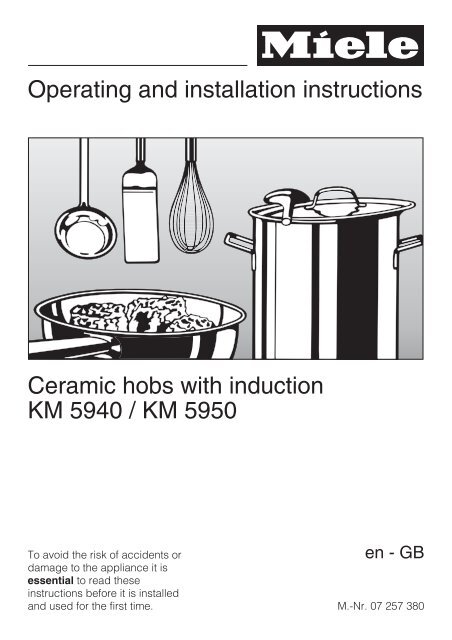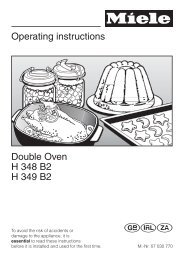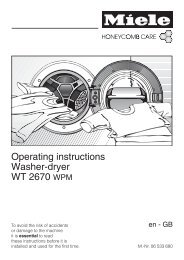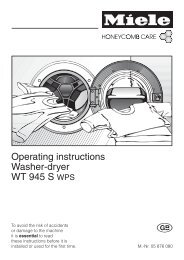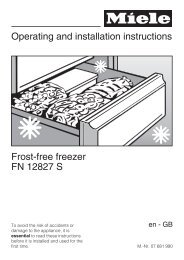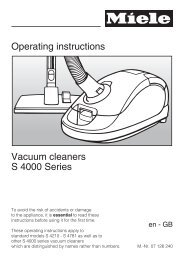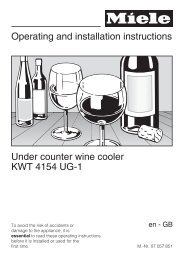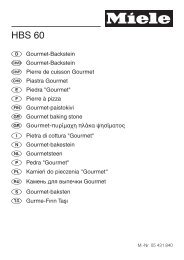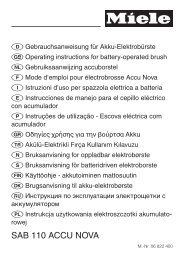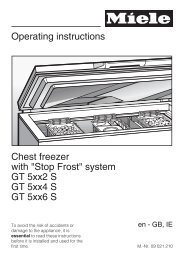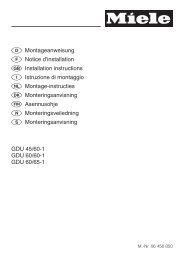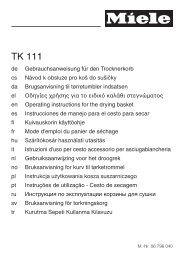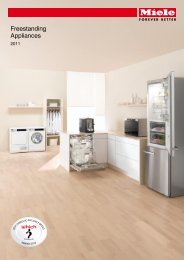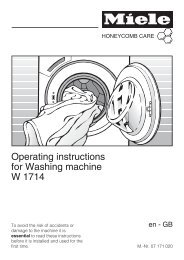Operating and installation instructions Ceramic hobs with ... - Miele
Operating and installation instructions Ceramic hobs with ... - Miele
Operating and installation instructions Ceramic hobs with ... - Miele
Create successful ePaper yourself
Turn your PDF publications into a flip-book with our unique Google optimized e-Paper software.
<strong>Operating</strong> <strong>and</strong> <strong>installation</strong> <strong>instructions</strong><br />
<strong>Ceramic</strong> <strong>hobs</strong> <strong>with</strong> induction<br />
KM 5940 / KM 5950<br />
To avoid the risk of accidents or<br />
en-GB<br />
damage to the appliance it is<br />
essential to read these<br />
<strong>instructions</strong> before it is installed<br />
<strong>and</strong> used for the first time. M.-Nr. 07 257 380
Contents<br />
Guide to the appliance .............................................4<br />
KM 5940. .........................................................4<br />
KM 5950. .........................................................5<br />
Control panel ......................................................6<br />
Cooking zone display ...............................................6<br />
Cooking zones .....................................................7<br />
Warning <strong>and</strong> Safety <strong>instructions</strong> .....................................8<br />
Caring for the environment. ........................................14<br />
Before using for the first time. ......................................15<br />
Cleaning for the first time. ...........................................15<br />
Before using for the first time. ........................................15<br />
Induction. .......................................................16<br />
The induction principle .............................................16<br />
Noises ..........................................................17<br />
Pans ............................................................18<br />
Use ............................................................19<br />
Sensor switches. ..................................................19<br />
Switching on .....................................................20<br />
Settings .........................................................21<br />
Auto heat-up .....................................................22<br />
Booster function. ..................................................23<br />
Switching off <strong>and</strong> residual heat indicators. ..............................24<br />
Safety features ...................................................25<br />
Safety lock .......................................................25<br />
Safety switch-off. ..................................................26<br />
Overheating protection .............................................27<br />
Cleaning <strong>and</strong> care ................................................28<br />
Programming ....................................................30<br />
2
Contents<br />
Problem solving guide ............................................31<br />
Optional accessories. .............................................33<br />
Safety <strong>instructions</strong> for <strong>installation</strong>. ..................................34<br />
Building-in dimensions ...........................................39<br />
KM 5940. ........................................................39<br />
KM 5950. ........................................................40<br />
Installation ......................................................41<br />
General <strong>installation</strong> tips ...........................................42<br />
Electrical connection. .............................................43<br />
Wiring diagram ...................................................45<br />
After sales service, data plate ......................................46<br />
3
Guide to the appliance<br />
KM 5940<br />
abcd Cooking zones<br />
e Control panel<br />
4
KM 5950<br />
abcd Cooking zones<br />
e Control panel<br />
Guide to the appliance<br />
5
Guide to the appliance<br />
Control panel<br />
Sensor switches for:<br />
a Booster<br />
b Power level <strong>and</strong> safety lock<br />
c Hob ON/OFF<br />
d Cooking zones ON/OFF<br />
Cooking zone display<br />
e Displays:<br />
0 = Cooking zone ready for use<br />
1 to 9 = Power levels<br />
# = Residual heat<br />
ß = No pan on cooking zone or pan unsuitable (see "Induction")<br />
P = Booster<br />
P0 etc. = Programme (see "Programming")<br />
S0 etc. = Status (see "Programming")<br />
f Indicator lamp for Booster<br />
g Indicator lamp for Auto heat-up, e.g. of the front left cooking zone<br />
6
Cooking zones<br />
Cooking zone KM 5940<br />
<br />
Minimum to maximum<br />
in cm*<br />
14 - 20 Normal:<br />
With Booster:<br />
14 - 20 Normal:<br />
With Booster:<br />
16 - 23 Normal:<br />
With Booster:<br />
10 - 16 Normal:<br />
With Booster:<br />
Guide to the appliance<br />
Rating in watts for 230 V**<br />
1850<br />
2500<br />
1850<br />
2500<br />
2300<br />
3200<br />
1400<br />
1800<br />
Total: 7400<br />
Cooking zone KM 5950<br />
Minimum to maximum<br />
in cm*<br />
Rating in watts for 230 V**<br />
16 - 23 Normal:<br />
2300<br />
With Booster:<br />
3200<br />
10 - 16 Normal:<br />
1400<br />
With Booster:<br />
1800<br />
14 - 20 Normal:<br />
1850<br />
With Booster:<br />
2500<br />
14 - 20 Normal:<br />
1850<br />
With Booster:<br />
2500<br />
Total: 7400<br />
* Pans of any diameter <strong>with</strong>in the given range may be used.<br />
** The wattage quoted may vary depending on the size <strong>and</strong> material of the pans<br />
used.<br />
7
Warning <strong>and</strong> Safety <strong>instructions</strong><br />
8<br />
This appliance complies <strong>with</strong> all<br />
relevant local <strong>and</strong> national safety<br />
requirements. Improper use of the<br />
appliance can, however, present a<br />
risk of both personal injury <strong>and</strong><br />
material damage.<br />
To avoid the risk of accidents <strong>and</strong><br />
damage to the appliance, please<br />
read these <strong>instructions</strong> carefully<br />
before <strong>installation</strong> <strong>and</strong> before using<br />
it for the first time.<br />
They contain important notes on the<br />
<strong>installation</strong>, safety, operation <strong>and</strong><br />
care of the appliance.<br />
Keep these <strong>instructions</strong> in a safe<br />
place <strong>and</strong> ensure that new users are<br />
familiar <strong>with</strong> the content. Pass them<br />
on to any future owner.<br />
Correct application<br />
This hob is not designed for<br />
commercial use. It is intended for use in<br />
domestic households <strong>and</strong> for use in<br />
similar working <strong>and</strong> residential<br />
environments such as:<br />
– Shops<br />
– Offices <strong>and</strong> showrooms<br />
<strong>and</strong> by residents in establishments<br />
such as:<br />
– hostels <strong>and</strong> guest houses.<br />
It must only be used as a domestic<br />
appliance to cook <strong>and</strong> keep food warm.<br />
Any other usage is not supported by<br />
the manufacturer <strong>and</strong> could be<br />
dangerous. <strong>Miele</strong> cannot be held liable<br />
for damage resulting from incorrect or<br />
improper use or operation of the<br />
appliance.<br />
This appliance is not intended for<br />
use by persons (including children)<br />
<strong>with</strong> reduced physical, sensory or<br />
mental capabilities, or lack of<br />
experience or knowledge, unless they<br />
are supervised whilst using it, or have<br />
been shown how to use it correctly by a<br />
person responsible for their safety.
Safety <strong>with</strong> children<br />
Use the safety lock to prevent<br />
children operating the appliance or<br />
altering the settings.<br />
Keep children away from the<br />
appliance at all times. It is not a toy! To<br />
avoid the risk of injury, do not allow<br />
them to play <strong>with</strong> it or use the controls.<br />
They will not underst<strong>and</strong> the potential<br />
dangers posed by it. They should be<br />
supervised whenever you are working<br />
in the kitchen.<br />
Older children may use the<br />
appliance only when its operation has<br />
been clearly explained to them <strong>and</strong><br />
they are able to use it safely,<br />
recognising the dangers of misuse.<br />
The appliance gets hot when in use<br />
<strong>and</strong> remains hot for quite a while after<br />
being switched off. To safeguard<br />
against burning, keep children well<br />
away from the appliance at all times.<br />
Do not store anything which might<br />
arouse a child’s interest in storage<br />
areas above or next to the appliance.<br />
Otherwise they could be tempted into<br />
climbing onto the appliance <strong>with</strong> the<br />
risk of burning themselves.<br />
Warning <strong>and</strong> Safety <strong>instructions</strong><br />
Keep all pans out of reach of<br />
children. Turn pan h<strong>and</strong>les inwards<br />
away from the edge of the hob. Danger<br />
of burning or scalding. Special hob<br />
guards are available from good retail<br />
outlets.<br />
Packaging, e.g. cling film,<br />
polystyrene <strong>and</strong> plastic wrappings,<br />
must be kept out of the reach of babies<br />
<strong>and</strong> young children. Danger of<br />
suffocation. Dispose of or recycle all<br />
packaging safely as soon as possible.<br />
9
Warning <strong>and</strong> Safety <strong>instructions</strong><br />
Technical safety<br />
Before <strong>installation</strong>, check the<br />
appliance for visible signs of damage.<br />
Do not install <strong>and</strong> use a damaged<br />
appliance, it could be dangerous.<br />
The electrical safety of this<br />
appliance can only be guaranteed<br />
when continuity is complete between it<br />
<strong>and</strong> an effective earthing system which<br />
complies <strong>with</strong> local <strong>and</strong> national safety<br />
regulations. It is most important that this<br />
basic safety requirement is present <strong>and</strong><br />
regularly tested, <strong>and</strong> where there is any<br />
doubt, the household wiring system<br />
should be inspected by a qualified<br />
electrician. The manufacturer cannot be<br />
held liable for the consequences of an<br />
inadequate earthing system (e.g.<br />
electric shock).<br />
Before connecting the appliance,<br />
make sure that the connection data on<br />
the data plate (voltage <strong>and</strong> connected<br />
load) match the mains electricity<br />
supply.<br />
This data must correspond in order to<br />
avoid the risk of damage to the<br />
appliance. Consult a qualified<br />
electrician if in any doubt.<br />
For safety reasons, this appliance<br />
may only be used after it has been built<br />
in.<br />
Never open the housing of the<br />
appliance.<br />
Tampering <strong>with</strong> electrical connections<br />
or components <strong>and</strong> mechanical parts is<br />
highly dangerous to the user <strong>and</strong> can<br />
cause operational faults.<br />
10<br />
Installation, maintenance <strong>and</strong><br />
repairs may only be carried out by a<br />
<strong>Miele</strong> authorised person in strict<br />
accordance <strong>with</strong> current national <strong>and</strong><br />
local safety regulations.<br />
Repairs <strong>and</strong> other work by unqualified<br />
persons could be dangerous. The<br />
manufacturer cannot be held liable for<br />
unauthorised work.<br />
During <strong>installation</strong>, maintenance <strong>and</strong><br />
repair work, the appliance must be<br />
disconnected from the mains electricity<br />
supply. It is only completely isolated<br />
from the electricity supply when:<br />
– the mains fuse is disconnected, or<br />
– the screw-out fuse is removed (in<br />
countries where this is applicable), or<br />
– it is switched off at the wall socket<br />
<strong>and</strong> the plug is <strong>with</strong>drawn from the<br />
socket, or it is switched off at the<br />
isolator.<br />
If the hob is fitted <strong>with</strong> a<br />
communication module this must be<br />
disconnected from the electricity<br />
supply during <strong>installation</strong> <strong>and</strong><br />
maintenance work <strong>and</strong> during any<br />
repair work to the hob.<br />
While the appliance is under<br />
guarantee, repairs should only be<br />
undertaken by a service technician<br />
authorised by the manufacturer.<br />
Otherwise the guarantee is invalidated.
Faulty components must only be<br />
replaced by genuine <strong>Miele</strong> original<br />
spare parts. The manufacturer can only<br />
guarantee the safety of the appliance<br />
when <strong>Miele</strong> replacement parts are<br />
used.<br />
If the connection cable is damaged,<br />
it must be replaced by a suitably<br />
qualified electrician <strong>with</strong> a specialist<br />
connection cable of type H 05 VV-F<br />
(pvc insulated), available from the <strong>Miele</strong><br />
Spare Parts Department.<br />
Do not connect the appliance to the<br />
mains electricity supply by a<br />
multi-socket unit or an extension lead.<br />
These do not guarantee the required<br />
safety of the appliance (e.g. danger of<br />
overheating).<br />
Do not use the hob if it is faulty, or if<br />
the ceramic surface is cracked,<br />
chipped or damaged in any way.<br />
Switch it off immediately, <strong>and</strong><br />
disconnect it from the mains electricity<br />
supply. Danger of electric shock.<br />
In countries where there are areas<br />
which may be subject to infestation by<br />
cockroaches or other vermin, pay<br />
particular attention to keeping the<br />
appliance <strong>and</strong> its surroundings in a<br />
clean condition at all times. Any<br />
damage caused by cockroaches or<br />
other vermin will not be covered by the<br />
guarantee.<br />
Warning <strong>and</strong> Safety <strong>instructions</strong><br />
Correct use<br />
For people fitted <strong>with</strong> a heart<br />
pacemaker:<br />
Please note that the area immediately<br />
surrounding the hob is<br />
electromagnetically charged. It is<br />
unlikely to affect a pacemaker.<br />
However, if in any doubt, consult the<br />
manufacturer of the pacemaker or your<br />
doctor.<br />
To prevent damage to items which<br />
are susceptible to magnetic fields, e.g.<br />
credit cards, diskettes, pocket<br />
calculators etc, do not leave them in the<br />
immediate vicinity of the hob.<br />
The appliance gets hot when in use<br />
<strong>and</strong> remains hot for quite a while after<br />
being switched off. There is a danger of<br />
burning until the residual heat<br />
indicators go out.<br />
Do not leave the appliance<br />
unattended whilst it is in use.<br />
Pans that have boiled dry can cause<br />
damage to the ceramic surface for<br />
which the manufacturer cannot be held<br />
liable.<br />
Boiling fat or oil could ignite <strong>and</strong> cause<br />
a fire.<br />
If, despite this, oil or fat does catch<br />
fire, do not attempt to put out the flames<br />
<strong>with</strong> water. Use a suitable fire blanket,<br />
saucepan lid, damp towel or similar to<br />
smother the flames.<br />
11
Warning <strong>and</strong> Safety <strong>instructions</strong><br />
For added protection, it is advisable<br />
to use heat-resistant pot holders or<br />
gloves when using the appliance. Do<br />
not let them get damp or wet, as this<br />
causes heat to transfer through the<br />
material more quickly <strong>with</strong> the risk of<br />
scalding or burning yourself.<br />
Do not flambé under a cooker hood.<br />
The flames could set the cooker hood<br />
on fire.<br />
Do not use the appliance as a<br />
resting place for anything else.<br />
Take particular care never to place<br />
cutlery or other metal objects on the<br />
appliance. When the appliance is<br />
switched on either deliberately or by<br />
mistake, or when there is residual heat<br />
present, there is the risk of metal<br />
objects heating up, <strong>with</strong> a danger of<br />
burning.<br />
Depending on the material, other<br />
objects left on the hob could also melt<br />
or catch fire.<br />
Damp pan lids might adhere to the<br />
ceramic surface <strong>and</strong> be difficult to<br />
dislodge.<br />
Switch the cooking zones off after use.<br />
Do not cover the appliance, e.g.<br />
<strong>with</strong> a cloth, kitchen foil, etc. This could<br />
be a fire hazard if the appliance is<br />
switched on by mistake.<br />
Do not use plastic or aluminium foil<br />
containers. These melt at high<br />
temperatures, <strong>and</strong> could catch fire.<br />
12<br />
Do not heat up unopened tins of<br />
food on the hob, as pressure will build<br />
up in the tin, causing it to explode. This<br />
could result in injury <strong>and</strong> scalding or<br />
damage.<br />
Do not use pots <strong>and</strong> pans on the<br />
ceramic hob <strong>with</strong> bases <strong>with</strong><br />
pronounced edges or ridges, e.g. cast<br />
iron pans. These could scratch or scour<br />
the hob surface permanently.<br />
Never heat an empty pan unless the<br />
manufacturer of the pan expressly<br />
states that you can do so. Because<br />
induction heating works extremely<br />
quickly the base of the pan could heat<br />
up to the temperature at which oil or fat<br />
self-ignites <strong>with</strong>in a very short time.<br />
Keep the hob clean. Grains of salt,<br />
sugar <strong>and</strong> s<strong>and</strong> (e.g. from cleaning<br />
vegetables) can cause scratches.<br />
Never place hot pans on the area<br />
around the controls. This could damage<br />
the electronic unit underneath.<br />
Do not drop anything on the ceramic<br />
surface. Even a light object could<br />
cause damage in certain<br />
circumstances.
Do not allow either solid or liquid<br />
sugar, or pieces of plastic or aluminium<br />
foil to get onto the cooking zones when<br />
they are hot. If this should occur, switch<br />
off the appliance, <strong>and</strong> carefully scrape<br />
off all the sugar, plastic or aluminium<br />
residues from the hob whilst they are<br />
still hot, using a shielded scaper blade.<br />
Take care not to burn yourself.<br />
If residues are allowed to cool before<br />
being removed, the ceramic surface<br />
will be susceptible to pitting or even<br />
cracking.<br />
Once the residues have been removed,<br />
allow the appliance to cool down, <strong>and</strong><br />
then clean <strong>with</strong> a suitable proprietary<br />
ceramic hob cleaner.<br />
When using an electric socket near<br />
the hob, care should be taken that the<br />
cable of the electrical appliance does<br />
not come into contact <strong>with</strong> a hot<br />
cooking zone. The insulation on the<br />
cable could become damaged, giving<br />
rise to an electric shock hazard.<br />
This appliance is fitted <strong>with</strong> a<br />
cooling fan. If a drawer is fitted directly<br />
underneath the hob, ensure that there<br />
is sufficient space between the drawer<br />
<strong>and</strong> its contents <strong>and</strong> the underside of<br />
the appliance in order to ensure<br />
sufficient ventilation for the hob. Do not<br />
store pointed or small items or paper in<br />
the drawer. They could get in through<br />
the ventilation slots or be sucked into<br />
the housing by the fan <strong>and</strong> damage the<br />
fan or impair cooling.<br />
Spray canisters, aerosols <strong>and</strong> other<br />
inflammable substances must not be<br />
stored in a drawer under the hob.<br />
Cutlery inserts must be heat-resistant.<br />
Warning <strong>and</strong> Safety <strong>instructions</strong><br />
Metal utensils stored in a drawer<br />
under the hob can become hot if the<br />
induction hob is used intensively for a<br />
long time.<br />
Always ensure that food is<br />
sufficiently cooked or reheated.<br />
Some foods may contain<br />
micro-organisms which are only<br />
destroyed by thorough cooking at a<br />
sufficiently high temperature for long<br />
enough. Therefore, when cooking or<br />
reheating food such as poultry, it is<br />
particularly important that the food is<br />
completely cooked through. If in doubt,<br />
select a longer cooking or reheating<br />
time.<br />
Do not use two pans on a<br />
cooking/extended zone at the same<br />
time.<br />
If the hob is installed behind a<br />
furniture door it may only be operated<br />
<strong>with</strong> the door open. Do not close the<br />
door whilst the hob is in use or whilst<br />
there is any residual heat left in the<br />
appliance.<br />
If the hob is built in over a pyrolitic<br />
oven, the hob should not be used whilst<br />
the pyrolitic process is being carried<br />
out, as this could trigger the<br />
overheating protection mechanism on<br />
the hob (see relevant section).<br />
The manufacturer cannot be held<br />
liable for damage caused by<br />
non-compliance <strong>with</strong> these Warning<br />
<strong>and</strong> Safety <strong>instructions</strong>.<br />
13
Caring for the environment<br />
Disposal of the packing<br />
material<br />
The transport <strong>and</strong> protective packing<br />
has been selected from materials which<br />
are environmentally friendly for<br />
disposal, <strong>and</strong> can normally be<br />
recycled.<br />
Ensure that any plastic wrappings,<br />
bags, etc. are disposed of safely <strong>and</strong><br />
kept out of the reach of babies <strong>and</strong><br />
young children. Danger of suffocation.<br />
Rather than just throwing these<br />
materials away, please ensure they are<br />
offered for recycling.<br />
14<br />
Disposal of your old appliance<br />
Electrical <strong>and</strong> electronic appliances<br />
often contain materials which, if<br />
h<strong>and</strong>led or disposed of incorrectly<br />
could be potentially hazardous to<br />
human health <strong>and</strong> to the environment.<br />
They are, however, essential for the<br />
correct functioning of your appliance.<br />
Please do not therefore dispose of it<br />
<strong>with</strong> your household waste.<br />
Please dispose of it at your local<br />
community waste collection/recycling<br />
centre or contact your dealer for<br />
advice. Ensure that it presents no<br />
danger to children while being stored<br />
for disposal.<br />
It should be unplugged or<br />
disconnected from the mains electricity<br />
supply by a competent person.
Please stick the extra data plate for the<br />
appliance supplied <strong>with</strong> this<br />
documentation in the space provided in<br />
the "After sales service, data plate"<br />
section of this booklet.<br />
Cleaning for the first time<br />
Remove any protective wrapping <strong>and</strong><br />
adhesive labels.<br />
Before using for the first time, clean the<br />
appliance <strong>with</strong> a damp cloth only <strong>and</strong><br />
then wipe dry.<br />
Do not use washing-up liquid to<br />
clean the ceramic surface as it can<br />
leave a blue sheen which may be<br />
difficult to remove.<br />
Before using for the first time<br />
Before using for the first time<br />
On <strong>hobs</strong> <strong>with</strong> bevelled glass edges,<br />
a small gap may be visible between<br />
the hob <strong>and</strong> the worktop during the<br />
first few days after <strong>installation</strong>. This<br />
gap will reduce <strong>with</strong> time as the<br />
appliance is used <strong>and</strong> will not affect<br />
the electrical safety of your<br />
appliance.<br />
When the appliance is used for the first<br />
time, it may give off a slight smell. The<br />
smell <strong>and</strong> any vapours will dissipate<br />
after a short time. They are not harmful<br />
<strong>and</strong> do not indicate a faulty connection<br />
or appliance.<br />
15
Induction<br />
The induction principle<br />
An induction coil is located under each<br />
cooking zone. When a cooking zone is<br />
switched on, this coil creates a<br />
magnetic field which impacts directly<br />
on the base of the pan <strong>and</strong> heats it up.<br />
The cooking zone itself is heated up<br />
indirectly by the heat given off by the<br />
pan.<br />
An induction cooking zone only works<br />
when a ferromagnetic pan is placed on<br />
it (see "Pans").<br />
Induction automatically recognises the<br />
size of the pan, i.e. heat is only<br />
generated in the area covered by the<br />
base of the pan.<br />
The cooking zone will not work:<br />
– if it is switched on <strong>with</strong>out a pan in<br />
place, or if the pan is unsuitable<br />
(non-magnetic base).<br />
– if the diameter of the base of the pan<br />
is too small.<br />
– if the pan is taken off the cooking<br />
zone when it is switched on.<br />
If this happens, ß will flash in the<br />
relevant cooking zone display<br />
alternating <strong>with</strong> 0 or the power setting<br />
selected .<br />
16<br />
If a suitable pan is placed on the<br />
cooking zone <strong>with</strong>in 3 minutes, the ß<br />
will go out <strong>and</strong> you can continue as<br />
normal.<br />
If no pan or an unsuitable pan is placed<br />
on the cooking zone, the cooking zone<br />
<strong>and</strong> the hob will switch off automatically<br />
after 3 minutes.<br />
Take particular care never to place<br />
cutlery or other metal objects on the<br />
hob. When the appliance is<br />
switched on either deliberately or by<br />
mistake, or when there is residual<br />
heat present, there is the risk of<br />
metal items heating up <strong>with</strong> the<br />
danger of burning.<br />
Switch the cooking zones off after<br />
use.
Noises<br />
When using an induction cooking zone,<br />
the following noises can occur in the<br />
pan, depending on what it is made of<br />
<strong>and</strong> how it has been constructed.<br />
– On the higher power settings, it<br />
might buzz. This will decrease or<br />
cease altogether when the power<br />
setting is reduced.<br />
– If the pan base is made of layers of<br />
different materials (e.g. in a<br />
s<strong>and</strong>wiched base), it might emit a<br />
cracking sound.<br />
– Whistling might occur if linked zones<br />
(see "Booster function") are being<br />
used at the same time, <strong>and</strong> the pans<br />
also have bases made of layers of<br />
different materials.<br />
– You might hear a clicking sound from<br />
the electronic switches, especially on<br />
lower settings.<br />
Induction<br />
The appliance has a cooling fan to help<br />
extend the life of the electronics. When<br />
the hob is being used intensively, this<br />
will come on <strong>and</strong> you will hear a<br />
whirring sound. The fan may continue<br />
to run after the appliance has been<br />
switched off.<br />
17
Induction<br />
Pans<br />
Suitable pans include:<br />
– stainless steel pans <strong>with</strong> a magnetic<br />
base<br />
– enamelled steel pans<br />
– cast iron pans<br />
Unsuitable pans:<br />
– stainless steel pans <strong>with</strong>out a<br />
magnetic base<br />
– aluminium <strong>and</strong> copper pans<br />
– glass, ceramic or earthenware pots<br />
<strong>and</strong> pans<br />
To test whether a pot or pan is suitable<br />
for use on an induction hob, hold a<br />
magnet to the base of the pan. If the<br />
magnet sticks, the pan is suitable.<br />
Please be aware that the properties of<br />
the pan base can affect the eveness<br />
<strong>with</strong> which food heats up in the pan.<br />
To make optimum use of the cooking<br />
zones, choose pans <strong>with</strong> base<br />
diameters larger than the innermost<br />
markings but smaller than the<br />
outermost markings. If the base<br />
diameter of the pan is smaller than the<br />
innermost marking, the induction<br />
heating will not work. The zone will<br />
behave as if it had no pan on it.<br />
Please note that the maximum diameter<br />
quoted by manufacturers often refers to<br />
the diameter of the top rim of the pot or<br />
pan. The diameter of the base<br />
(generally smaller) is more important.<br />
18<br />
Make sure that you always place the<br />
pan in the middle of the cooking<br />
zone. If the pan only partially covers<br />
the zone, the h<strong>and</strong>le could become<br />
very hot.<br />
Tips on saving energy<br />
Use a lid whenever possible to<br />
minimise heat loss.<br />
Uncovered Covered
Sensor switches<br />
This hob is equipped <strong>with</strong> electronic<br />
sensor switches which react to finger<br />
contact.<br />
To operate a cooking zone, touch the<br />
relevant sensor. Each time you touch a<br />
sensor, an audible tone sounds.<br />
Use<br />
Take care to keep the control panel<br />
clean <strong>and</strong> do not place anything on<br />
top of it. The sensor switches may<br />
fail to react or they could mistake the<br />
article or any dirt for a fingertip<br />
contact, thereby activating a<br />
function or even causing the hob to<br />
switch off automatically (see Safety<br />
switch-off.)<br />
Never place hot pans on the sensor<br />
switches. The electronic unit<br />
underneath could get damaged.<br />
19
Use<br />
Switching on<br />
The hob must be switched on before<br />
any of the zones can be used.<br />
Do not leave the appliance<br />
unattended whilst it is being used.<br />
To switch the hob on<br />
Touch the ON/OFF sensor .<br />
0 appears in each of the cooking zone<br />
displays. If no further entry is made, the<br />
hob will switch itself off after a few<br />
seconds for safety reasons.<br />
To switch a cooking zone on<br />
Briefly touch the area under the<br />
cooking zone display required once.<br />
A 0 will flash in the display.<br />
Whilst the 0 is flashing, select a<br />
power setting of between 1 <strong>and</strong> 9 by<br />
touching the - or + sensor.<br />
20<br />
To select cooking <strong>with</strong> Auto heat-up,<br />
press the - sensor first (see "Auto<br />
heat-up"). To select cooking <strong>with</strong>out<br />
Auto heat-up, press the + sensor first.<br />
The power setting selected flashes in<br />
the display for a few seconds to start<br />
<strong>with</strong> <strong>and</strong> then lights up constantly.<br />
To change a power setting which has<br />
already been set, touch the sensor<br />
under the relevant cooking zone<br />
display once briefly. The power setting<br />
can then be changed using the - <strong>and</strong> +<br />
sensors.
Settings<br />
Cooking process Settings*<br />
Melting butter<br />
Dissolving gelatine<br />
1-2<br />
Warming small quantities of food/liquid<br />
Keeping warm food which sticks easily<br />
Cooking rice<br />
Defrosting frozen vegetables<br />
Warming liquid <strong>and</strong> semi-solid foods<br />
Thickening sauces, e.g. Holl<strong>and</strong>aise<br />
Making porridge<br />
Preparing omelettes, lightly fried eggs<br />
Steaming fruit<br />
Defrosting deep frozen food<br />
Steaming vegetables, fish<br />
Cooking broths, pulse soups<br />
Bringing large quantities of food to the boil<br />
6<br />
Cooking dumplings<br />
Gentle braising (<strong>with</strong>out overheating the fat) of meat, fish,<br />
7<br />
vegetables, fried eggs<br />
Frying pancakes etc. 8<br />
Boiling large quantities of water<br />
9<br />
Bringing to the boil<br />
* These settings, which envisage approx. 4 servings, should only be taken as a<br />
guide. With deep pans, large quantities or when cooking <strong>with</strong>out the lid, a<br />
higher setting is required. For smaller quantities, select a lower setting.<br />
3<br />
4<br />
5<br />
Use<br />
21
Use<br />
Auto heat-up<br />
When Auto heat-up has been activated,<br />
the cooking zone switches on<br />
automatically at the highest setting <strong>and</strong><br />
then switches to the continued cooking<br />
setting which you have previously<br />
selected. The heat-up time depends on<br />
which continued cooking setting has<br />
been chosen (see chart).<br />
Taking a pan off the zone whilst Auto<br />
heat-up is in operation interrupts the<br />
Auto heat-up. It will resume if a pan is<br />
placed back on the zone <strong>with</strong>in 3<br />
minutes.<br />
22<br />
Continued<br />
cooking setting<br />
Heat-up time<br />
in minutes <strong>and</strong><br />
seconds<br />
(approx.)<br />
1 0:15<br />
2 0:15<br />
3 0:25<br />
4 0:50<br />
5 2:00<br />
6 5:50<br />
7 2:50<br />
8 2:50<br />
9 -<br />
To activate Auto heat-up<br />
While a 0 is flashing in the cooking<br />
zone display, touch the - sensor until<br />
the required continued cooking<br />
setting appears, e.g. 6.<br />
During the heat-up time an indicator<br />
lamp to the right of the continued<br />
cooking setting will light up, <strong>and</strong> go out<br />
at the end of it.<br />
At any point during the Auto heat-up<br />
time you can use - or + to lower or<br />
increase the continued cooking setting.<br />
The Auto heat-up time will alter<br />
accordingly.
Booster function<br />
Each cooking zone has a Booster<br />
function.<br />
When activated, the zones will operate<br />
on power setting 9 <strong>with</strong> an extra boost<br />
of power for a period of 10 minutes.<br />
This boost is intended for quickly<br />
bringing large quantities of water to the<br />
boil, e.g. when cooking pasta.<br />
The Booster function can only be used<br />
on two cooking zones at the same time,<br />
one on the left <strong>and</strong> one on the right.<br />
If the Booster function is switched on<br />
when<br />
– no setting has been selected, the<br />
cooking zone will revert automatically<br />
to power setting 9 at the end of the<br />
Booster time or if the Booster<br />
function is switched off before this.<br />
– a setting has been selected, the<br />
cooking zone will revert automatically<br />
to the setting selected at the end of<br />
the Booster time or if the Booster<br />
function is switched off before this.<br />
Taking a pan off the zone whilst the<br />
Booster is in operation interrupts the<br />
Booster function. It will resume if a pan<br />
is placed back on the zone <strong>with</strong>in 3<br />
minutes.<br />
Use<br />
The extra boost of energy is only<br />
available by taking a proportion of<br />
energy away from another cooking<br />
zone. For this reason, the cooking<br />
zones are networked in pairs as shown.<br />
When the booster is switched on, the<br />
following happens:<br />
– if Auto heat-up is activated on either<br />
zone in the same network, this will be<br />
switched off.<br />
– the power level on the other linked<br />
cooking zone will sometimes<br />
decrease.<br />
To switch on the Booster function<br />
Touch the sensor for the relevant<br />
cooking zone.<br />
Press the B sensor.<br />
A P will start to flash in the display for<br />
the cooking zone, <strong>and</strong> the indicator<br />
lamp for the booster will light up.<br />
After a few seconds, P will light up<br />
constantly <strong>and</strong> the indicator lamp will<br />
go out.<br />
To switch off the Booster function<br />
Touch the sensor for the relevant<br />
cooking zone.<br />
Press the booster sensor switch B or<br />
- for the relevant cooking zone.<br />
23
Use<br />
Switching off <strong>and</strong> residual heat<br />
indicators<br />
To switch off a cooking zone<br />
Touch the sensor switch for the<br />
relevant cooking zone twice.<br />
A 0 flashes in the cooking zone display<br />
for a few seconds. If the cooking zone<br />
is still hot, the residual heat indicator<br />
will then appear in the display.<br />
To switch off the hob<br />
Touch the ON/OFF sensor .<br />
This switches off all cooking zones. The<br />
residual heat indicator will appear in the<br />
display of any cooking zone which is<br />
still hot.<br />
24<br />
The lines of the residual heat indicator<br />
go out one after another as the cooking<br />
zones cool down. The last horizontal<br />
line only goes out when the cooking<br />
zone is safe to touch.<br />
The residual heat indicators also<br />
react to hot dishes <strong>and</strong> plates being<br />
placed on a cooking zone that is not<br />
switched on.<br />
Do not touch any zone or place any<br />
heat sensitive items on a zone where<br />
the residual heat indicators are lit<br />
up.<br />
Danger of burning <strong>and</strong> fire hazard.
Safety lock<br />
Keep children away from the hob for<br />
their own safety.<br />
Your appliance is equipped <strong>with</strong> a<br />
safety lock to prevent the hob <strong>and</strong> the<br />
cooking zones being switched on or<br />
any settings being altered.<br />
The safety lock can be activated when<br />
the hob is switched off as well as when<br />
it is in use.<br />
If the safety lock is activated when the<br />
hob is switched off, then the hob<br />
cannot be switched on.<br />
If the safety lock is activated when the<br />
hob is in use:<br />
– The power settings for the cooking<br />
zones cannot be changed.<br />
– The cooking zones <strong>and</strong> hob can be<br />
switched off, but once switched off<br />
cannot be switched on again.<br />
If a sensor is touched when the safety<br />
lock is activated, the keypad tone<br />
emitted is slightly longer than normal.<br />
The safety lock is deactivated if<br />
there is a power cut.<br />
Safety features<br />
To activate the safety lock<br />
Touch the - <strong>and</strong> + sensors at the<br />
same time until an audible tone<br />
sounds.<br />
To deactivate the safety lock<br />
Touch the - <strong>and</strong> + sensors at the<br />
same time until an audible tone<br />
sounds.<br />
25
Safety features<br />
Safety switch-off<br />
Your hob is fitted <strong>with</strong> a safety<br />
switch-off feature in case you forget to<br />
switch it off yourself.<br />
Safety switch-off <strong>with</strong> an over-long<br />
cooking time<br />
If one of the cooking zones is heated<br />
for an unusually long period of time<br />
(see chart) <strong>and</strong> the power settings are<br />
not altered, the hob will switch itself off<br />
automatically <strong>and</strong> the appropriate<br />
residual heat indicator will appear.<br />
To use the cooking zone again, switch<br />
it back on in the usual way.<br />
Power setting Maximum<br />
operating time<br />
in hours<br />
1 10<br />
2 10<br />
3 5<br />
4 4<br />
5 3<br />
6 3<br />
7 2<br />
8 2<br />
9 1<br />
26<br />
Safety switch-off if the sensors are<br />
covered<br />
Your hob will switch itself off<br />
automatically if one or several of the<br />
sensor controls remain covered for<br />
more than about 10 seconds, for<br />
example by finger contact, food boiling<br />
over, or by an object such as an oven<br />
glove or a tea towel. The residual heat<br />
indicator will appear in the display of<br />
any cooking zones that are still hot.<br />
Clean the control panel or remove the<br />
obstruction.<br />
Switch the hob back on again <strong>with</strong><br />
the ON/OFF sensor . The cooking<br />
zones can now be used again as<br />
normal.
Overheating protection<br />
All the induction coils <strong>and</strong> the cooling<br />
elements for the electronics are fitted<br />
<strong>with</strong> an overheating protection<br />
mechanism. To prevent the induction<br />
coils <strong>and</strong> cooling elements from<br />
overheating, the overheating protection<br />
mechanism works on the affected<br />
cooking zone or on the entire hob in the<br />
following ways:<br />
– If the booster function is being used,<br />
this will be switched off.<br />
– The power setting will be reduced.<br />
– If an induction coil is affected, the<br />
affected cooking zone will be<br />
switched off automatically.<br />
The cooking zone can only be used<br />
again when the induction coil has<br />
cooled down sufficiently.<br />
– If a cooling element is affected, the<br />
cooking zones concerned will be<br />
switched off automatically.<br />
The affected cooking zones can only<br />
be used again as usual once the<br />
cooling element has cooled down to a<br />
safe level.<br />
Safety features<br />
Overheating can be caused by:<br />
– Heating up an empty pan<br />
– Fats or oils being heated up on the<br />
highest power setting.<br />
– There being insufficient ventilation to<br />
the underside of the appliance.<br />
If the overheating protection<br />
mechanism triggers again, contact the<br />
Service department.<br />
27
Cleaning <strong>and</strong> care<br />
A range of <strong>Miele</strong> br<strong>and</strong>ed cleaning<br />
products is available from <strong>Miele</strong>. See<br />
"Optional accessories" for details.<br />
Do not use a steam cleaning<br />
appliance to clean this appliance.<br />
The steam could reach the electrical<br />
components <strong>and</strong> cause a short<br />
circuit.<br />
The appliance should be cleaned<br />
regularly, preferably after each use.<br />
Allow it to cool down to room<br />
temperature before cleaning.<br />
To avoid water marks <strong>and</strong> limescale<br />
deposits, use a soft cloth to dry<br />
surfaces that have been cleaned <strong>with</strong><br />
water.<br />
28<br />
To avoid damaging the outer<br />
surfaces of your appliance, do not<br />
use:<br />
– cleaning agents containing soda,<br />
alkalines, ammonia, acids or<br />
chlorides,<br />
– cleaning agents containing<br />
descaling agents,<br />
– stain or rust removers,<br />
– abrasive cleaning agents, e.g.<br />
powder cleaners <strong>and</strong> cream<br />
cleaners,<br />
– solvent-based cleaning agents,<br />
– dishwasher cleaner,<br />
– grill <strong>and</strong> oven cleaners,<br />
– glass cleaning agents,<br />
– hard, abrasive brushes or sponges,<br />
e.g. pot scourers, brushes or<br />
sponges which have been previously<br />
used <strong>with</strong> abrasive cleaning agents,<br />
– sharp, pointed objects which could<br />
damage the seal between the<br />
ceramic surface <strong>and</strong> the surrounding<br />
frame, <strong>and</strong> between the frame <strong>and</strong><br />
the worktop.
<strong>Ceramic</strong> surface<br />
Wipe all coarse soiling off using a<br />
damp cloth. Stubborn soiling may need<br />
to be removed <strong>with</strong> a shielded scraper<br />
blade.<br />
Then clean the hob <strong>with</strong> a suitable<br />
proprietary ceramic <strong>and</strong> stainless steel<br />
hob cleaner (see "Optional<br />
accessories") applied <strong>with</strong> kitchen<br />
paper or a clean cloth. Do not apply<br />
cleaner whilst the hob is still hot, as this<br />
could result in marking. Please follow<br />
the manufacturer’s <strong>instructions</strong>.<br />
Finally, wipe the hob <strong>with</strong> a damp cloth,<br />
then polish <strong>with</strong> a soft, dry cloth. Ensure<br />
that all cleaner residues are removed.<br />
Residues can burn onto the appliance<br />
the next time it is used, <strong>and</strong> cause<br />
damage to the ceramic surface.<br />
Cleaning <strong>and</strong> care<br />
Marks caused by limescale, water <strong>and</strong><br />
aluminium residues (shimmering,<br />
metallic appearance) can be removed<br />
using the ceramic <strong>and</strong> stainless steel<br />
hob cleaner.<br />
Should any sugar, plastic or<br />
aluminium foil spill or fall onto a hot<br />
cooking zone while it is in use, first<br />
switch off the appliance. Then carefully<br />
scrape off all the sugar, plastic or<br />
aluminium residues from the hob whilst<br />
they are still hot, using a shielded<br />
scraper blade. Take care not to burn<br />
yourself.<br />
Allow the appliance to cool down, <strong>and</strong><br />
then clean as described above <strong>with</strong> a<br />
suitable proprietary ceramic <strong>and</strong><br />
stainless steel hob cleaner.<br />
29
Programming<br />
You can change the st<strong>and</strong>ard settings<br />
of your hob.<br />
With the hob switched off, touch the<br />
hob ON/OFF sensor <strong>and</strong> the<br />
booster sensor B at the same time,<br />
until P (Programme), S (Status) <strong>and</strong><br />
numbers appear in the cooking zone<br />
displays. This shows the current<br />
setting.<br />
To set the programme:<br />
Touch the sensor for the front left<br />
cooking zone.<br />
The relevant number will begin to flash.<br />
Touch the + or - sensor to set the<br />
required programme.<br />
To set the status:<br />
Touch sensor for the front right<br />
cooking zone.<br />
The relevant number will begin to flash.<br />
Touch the + or - sensor to set the<br />
required status.<br />
To store the new settings in memory,<br />
touch the B sensor until the displays go<br />
out.<br />
If you do not wish to store the settings<br />
in memory, touch the ON/OFF sensor<br />
until the displays go out.<br />
Programme Status* Setting<br />
P 0 Demonstration mode <strong>and</strong> factory S 0 Demonstration mode on<br />
default settings<br />
S 1 Demonstration mode off<br />
S 9 Factory default settings<br />
reinstated<br />
P 1 Keypad tone when a sensor is S 0 Off<br />
touched<br />
S 1 On<br />
* The factory default settings are shown in bold.<br />
30
Installation work <strong>and</strong> repairs to<br />
electrical appliances must only be<br />
carried out by a suitably qualified<br />
<strong>and</strong> competent person in strict<br />
accordance <strong>with</strong> current local <strong>and</strong><br />
national safety regulations (BS 7671<br />
in the UK). Repairs <strong>and</strong> other work<br />
by unqualified persons could be<br />
dangerous. The manufacturer<br />
cannot be held liable for<br />
unauthorised work.<br />
Ensure that current is not supplied to<br />
the appliance until after<br />
maintenance or repair work has<br />
been carried out.<br />
What to do if...<br />
... the hob or cooking zones cannot<br />
be switched on.<br />
Check whether<br />
– the pans being used are suitable.<br />
– the safety lock is activated.<br />
If necessary, deactivate it (see<br />
"Safety lock").<br />
– the mains fuse has tripped.<br />
If none of the above is the case, then<br />
disconnect the appliance from the<br />
electricity supply for approx. 1 minute.<br />
To do this:<br />
– switch off at the wall socket, or<br />
switch off at the isolator, or<br />
– disconnect the mains fuse.<br />
Reset the trip switch in the mains fuse<br />
box, <strong>and</strong> switch the appliance back on.<br />
If it still will not switch on, contact a<br />
qualified electrician or the <strong>Miele</strong> Service<br />
Department.<br />
Problem solving guide<br />
... there is a strange smell or vapours<br />
when a new appliance is being used.<br />
The smell <strong>and</strong> any vapours given off do<br />
not indicate a faulty connection or<br />
appliance, <strong>and</strong> neither are they<br />
hazardous to health.<br />
... the hob can be switched on <strong>and</strong><br />
settings selected, but the cooking<br />
zones do not heat up.<br />
Check whether you set the demo-mode<br />
setting by mistake (see "Programming -<br />
P0").<br />
... ß appears in the display for a<br />
cooking zone.<br />
Check whether<br />
– the zone was switched on by mistake<br />
<strong>with</strong>out a pan on it.<br />
– the pan being used is suitable for<br />
use on an induction zone, <strong>and</strong> that it<br />
is large enough (see "Pans").<br />
... an individual cooking zone or the<br />
whole hob has switched itself off<br />
automatically.<br />
The safety switch-off feature or the<br />
overheating protection mechanism has<br />
been triggered (see "Safety switch-off"<br />
<strong>and</strong> "Overheating protection").<br />
31
Problem solving guide<br />
... one of the following has occurred:<br />
– The Booster has switched off early<br />
automatically.<br />
– The power setting selected has been<br />
reduced.<br />
– The cooking zone is not working in<br />
the usual way at the power setting<br />
selected.<br />
The overheating protection mechanism<br />
has been triggered (see "Overheating<br />
protection").<br />
... the food in the pan hardly heats up<br />
or does not heat up at all when the<br />
Auto heat-up function is switched on<br />
This could be because:<br />
– there is too much food in the pan.<br />
– the pan is not conducting heat<br />
properly.<br />
Select a higher continued cooking<br />
setting next time, or start cooking at the<br />
highest setting <strong>and</strong> then turn down to a<br />
lower setting manually later on.<br />
32<br />
... the cooling fan continues to run<br />
after the appliance has been<br />
switched off.<br />
This is not a fault. The fan will continue<br />
running until the appliance has cooled<br />
down. It will then switch itself off<br />
automatically.
<strong>Miele</strong> appliances are designed to give the best possible<br />
results <strong>and</strong> years of satisfaction. To help you get the most<br />
from your appliance, <strong>Miele</strong> has put together a comprehensive<br />
range of accessories <strong>and</strong> cleaning products.<br />
These can be ordered via the internet at:<br />
Optional accessories<br />
or from <strong>Miele</strong> (see back cover for contact details).<br />
33
Safety <strong>instructions</strong> for <strong>installation</strong><br />
The appliance must only be installed<br />
<strong>and</strong> connected to the electricity<br />
supply by a suitably qualified <strong>and</strong><br />
competent person in strict<br />
accordance <strong>with</strong> current national<br />
<strong>and</strong> local safety regulations<br />
(BS 7671 in the UK).<br />
Fit the wall units <strong>and</strong> extractor hood<br />
before fitting the hob to avoid<br />
damaging the appliance.<br />
The veneer or laminate coatings of<br />
worktops (or adjacent kitchen units)<br />
must be treated <strong>with</strong> 100 °C<br />
heat-resistant adhesive which will not<br />
dissolve or distort.<br />
Any backmoulds must be of<br />
heat-resistant material.<br />
This equipment may only be used in<br />
mobile <strong>installation</strong>s such as ships, if a<br />
risk assessment has been carried out<br />
by a suitably qualified engineer.<br />
The hob may not be built in over a<br />
fridge, fridge freezer, freezer,<br />
dishwasher, washing machine or<br />
tumble dryer.<br />
This hob must not be installed<br />
above an oven or cooker unless this<br />
has built-in cooling down fan.<br />
34<br />
After installing the hob, ensure that<br />
the connection cable cannot come into<br />
contact <strong>with</strong> the underside of the<br />
appliance. Make sure that there is no<br />
mechanical obstruction, such as a<br />
drawer, which could damage it.<br />
Observe carefully the safety<br />
distances given on the following pages.<br />
All dimensions in this instruction booklet<br />
are given in mm.
Safety distance above the appliance<br />
A minimum safety distance must be<br />
maintained between the appliance <strong>and</strong><br />
the cooker hood above it. See the<br />
cooker hood manufacturer’s operating<br />
<strong>and</strong> <strong>installation</strong> <strong>instructions</strong> for details.<br />
If the manufacturer’s <strong>instructions</strong> are<br />
not available for the cooker hood, a<br />
minimum safety distance of at least<br />
760 mm must be maintained. For any<br />
flammable objects, e.g. utensil rails,<br />
wall units etc. a minimum distance of at<br />
least 760 mm must be maintained<br />
between them <strong>and</strong> the appliance<br />
below.<br />
Safety <strong>instructions</strong> for <strong>installation</strong><br />
When two or more appliances are<br />
installed together below a cooker<br />
hood, e.g. a gas wok <strong>and</strong> a ceramic<br />
hob, which have different safety<br />
distances given in the <strong>installation</strong><br />
<strong>instructions</strong>, you should select the<br />
greater distance of the two.<br />
35
Safety <strong>instructions</strong> for <strong>installation</strong><br />
Safety distances to the sides <strong>and</strong><br />
back of the hob<br />
Ideally the hob should be installed <strong>with</strong><br />
plenty of space on either side. There<br />
may be a wall at the rear <strong>and</strong> a tall unit<br />
or wall at one side. On the other side,<br />
however, no unit or divider should<br />
st<strong>and</strong> higher than the hob (see<br />
illustrations).<br />
The following minimum distances<br />
should be adhered to for safety<br />
reasons:<br />
– 50 mm to the right or left of the<br />
worktop cut-out to the nearest piece<br />
of furniture (e.g. tall unit).<br />
– 50 mm from the worktop cut-out to<br />
the rear wall.<br />
36<br />
Not allowed<br />
Recommended<br />
Not recommended
Safety distances underneath the hob<br />
To ensure sufficient ventilation to the<br />
hob, a certain gap must be left between<br />
the underside of the hob <strong>and</strong> any oven,<br />
interim shelf or drawer.<br />
The minimum gap between the<br />
underside of the hob <strong>and</strong><br />
– the top of an oven is 15 mm.<br />
– the top of an interim shelf is 15 mm.<br />
A space of at least 10 mm must also<br />
be left at the back to accommodate<br />
the cable.<br />
– the base of a drawer must be<br />
75 mm.<br />
Safety <strong>instructions</strong> for <strong>installation</strong><br />
37
Safety <strong>instructions</strong> for <strong>installation</strong><br />
Safety distance when installing the appliance near a wall <strong>with</strong> additional<br />
niche cladding<br />
A minimum safety distance must be maintained between the worktop cut-out <strong>and</strong><br />
any niche cladding to protect it from heat damage.<br />
If the niche cladding is made from a combustible material (e. g. wood) a<br />
minimum safety distance e of 50 mm must be maintained between the cut-out<br />
<strong>and</strong> the cladding.<br />
If the niche cladding is made from a non-combustible material (e. g. metal,<br />
natural stone, ceramic tiles) a minimum safety distance e of 50 mm less the<br />
thickness of the cladding must be maintained between the cut-out <strong>and</strong> the<br />
cladding.<br />
Example: 15 mm niche cladding<br />
50 mm - 15 mm = minimum safety distance of 35 mm<br />
Flush-fitted <strong>hobs</strong> Hob <strong>with</strong> frame or bevelled edges<br />
a Masonry<br />
b Niche cladding<br />
Dimension x = thickness of niche cladding material<br />
c Worktop<br />
d Worktop cut-out<br />
e Minimum safety distance<br />
for combustible materials is 50 mm<br />
for non-combustible materials is 50 mm less dimension x<br />
38
KM 5940<br />
0<br />
574<br />
50<br />
a<br />
490<br />
422<br />
a Front<br />
b Building-in depth<br />
c Mains connection cable, L = 1440 mm<br />
+ 3<br />
560<br />
b<br />
48<br />
c<br />
+3<br />
Building-in dimensions<br />
a<br />
504<br />
209<br />
ßR4<br />
3<br />
250<br />
475<br />
b<br />
48<br />
0 30<br />
39
Building-in dimensions<br />
KM 5950<br />
a Front<br />
b Building-in depth<br />
c Mains connection cable, L = 1440 mm<br />
40<br />
0 50<br />
764<br />
b<br />
15<br />
a<br />
422<br />
490 750<br />
+ 3<br />
b<br />
48<br />
b<br />
15<br />
+3<br />
209<br />
149<br />
a<br />
c<br />
504<br />
225<br />
d<br />
ß R4<br />
220<br />
3<br />
250<br />
354<br />
b<br />
32<br />
48<br />
0 30
Preparing the worktop<br />
Make the worktop cut-out according<br />
to the dimensions given in the<br />
building-in diagram. Remember to<br />
maintain the minimum safety<br />
distances (see "Safety <strong>instructions</strong><br />
for <strong>installation</strong>").<br />
Seal the cut surfaces on<br />
wood/laminated worktops <strong>with</strong> a<br />
suitable heat-resistant sealant to<br />
avoid swelling caused by moisture.<br />
Make sure that the sealant does not<br />
come into contact <strong>with</strong> the top of the<br />
worktop.<br />
These <strong>hobs</strong> have a seal underneath<br />
them to keep the hob securely in<br />
position. Clamps are not required.<br />
Any gap between the frame <strong>and</strong><br />
worktop will reduce <strong>with</strong> time.<br />
Installation<br />
Installing the hob<br />
Feed the hob connection cable down<br />
through the cut-out.<br />
Place the hob centrally in the cut-out.<br />
When doing this make sure that the<br />
seal under the hob sits flush <strong>with</strong> the<br />
worktop on all sides. This is important<br />
to ensure an effective seal all round.<br />
Do not use sealant (e.g. silicone).<br />
If the corners of the frame are not<br />
flush <strong>with</strong> the worktop surface, the<br />
corner radius ( R4) can be carefully<br />
scribed to fit.<br />
Connect the hob to the mains.<br />
Check that the hob works.<br />
41
General <strong>installation</strong> tips<br />
Do not use any sealant unless<br />
expressly instructed to do so. The<br />
sealing strip under the edge of the top<br />
part of the appliance provides a<br />
sufficient seal for the worktop.<br />
42<br />
Do not use sealant between the<br />
frame of the top part of the hob <strong>and</strong><br />
the worktop.<br />
This could cause difficulties if the<br />
hob ever needs to be taken out for<br />
servicing <strong>and</strong> possibly result in<br />
damage to the frame or the worktop.<br />
Tiled worktop<br />
Grout lines a <strong>and</strong> the hatched area<br />
underneath the hob frame must be<br />
smooth <strong>and</strong> even. If they are not the<br />
hob will not sit flush <strong>with</strong> the worktop<br />
<strong>and</strong> the sealing strip underneath the<br />
hob will not provide a good seal<br />
between the hob <strong>and</strong> the worktop.
All electrical work should be carried<br />
out by a suitably qualified <strong>and</strong><br />
competent person, in strict<br />
accordance <strong>with</strong> current local <strong>and</strong><br />
national safety regulations (BS 7671<br />
in the UK).<br />
Installation, repairs <strong>and</strong> other work<br />
by unqualified persons could be<br />
dangerous. The manufacturer<br />
cannot be held liable for<br />
unauthorised work.<br />
A damaged cable must be replaced<br />
by a suitably qualified electrician<br />
<strong>with</strong> a special connection cable of<br />
type H 05 VV-F, available from<br />
<strong>Miele</strong>.<br />
Ensure power is not supplied to the<br />
appliance until after <strong>installation</strong> or<br />
repair work has been carried out.<br />
The appliance must only be<br />
operated when built-in. This is to<br />
ensure that all electrical parts are<br />
shielded. Live parts must not be<br />
exposed.<br />
Do not connect the appliance to the<br />
mains electricity supply by an<br />
extension lead. These do not<br />
guarantee the required safety of the<br />
appliance.<br />
Please make sure that the connection<br />
data quoted on the data plate match<br />
the household mains supply.<br />
Electrical connection<br />
Connection should be made via a<br />
suitable isolator which complies <strong>with</strong><br />
national <strong>and</strong> local safety regulations,<br />
<strong>and</strong> the On/Off switch should be easily<br />
accessible after the appliance has<br />
been built in.<br />
If the switch is not accessible after<br />
<strong>installation</strong> (depending on country) an<br />
additional means of disconnection must<br />
be provided for all poles.<br />
For extra safety it is advisable to protect<br />
the appliance <strong>with</strong> a residual current<br />
device (RCD). Please contact a<br />
qualified electrician for advice.<br />
When switched off there must be an<br />
all-pole contact gap of at least 3 mm in<br />
the isolator switch (including switch,<br />
fuses <strong>and</strong> relays).<br />
Important U.K.<br />
The appliance is supplied for<br />
connection to a 230-240 V, 50 Hz<br />
supply <strong>with</strong> a 3-core cable.<br />
The wires in the mains lead are<br />
coloured in accordance <strong>with</strong> the<br />
following code:<br />
Green/yellow = earth<br />
Blue = neutral<br />
Brown = live<br />
WARNING<br />
THIS APPLIANCE MUST BE<br />
EARTHED<br />
43
Electrical connection<br />
The electrical safety of this appliance<br />
can only be guaranteed when<br />
continuity is complete between it <strong>and</strong><br />
an effective earthing system, which<br />
complies <strong>with</strong> current local <strong>and</strong> national<br />
safety regulations. It is most important<br />
that this basic safety requirement is<br />
present <strong>and</strong> regularly tested <strong>and</strong> where<br />
there is any doubt, the electrical wiring<br />
in the home should be inspected by a<br />
qualified electrician. The manufacturer<br />
cannot be held liable for the<br />
consequences of an inadequate<br />
earthing system such as an electric<br />
shock.<br />
44<br />
The manufacturer cannot be held<br />
liable for damage which is the direct<br />
or indirect result of incorrect<br />
<strong>installation</strong> or connection.
Wiring diagram<br />
Electrical connection<br />
N.B. This appliance is supplied single phase only in the U.K. / AUS / NZ<br />
45
After sales service, data plate<br />
In the event of any faults which you cannot remedy yourself, or if the appliance is<br />
under guarantee, please contact:<br />
– Your <strong>Miele</strong> dealer, or<br />
– the <strong>Miele</strong> Service Department (see back cover for address).<br />
Please note that telephone calls may be monitored <strong>and</strong> recorded to improve<br />
our service.<br />
When contacting <strong>Miele</strong>, please quote the model <strong>and</strong> serial number of your<br />
appliance. These are given on the data plate.<br />
N.B. A call-out charge will be applied for service visits where the problem<br />
could have been resolved as described in these <strong>instructions</strong>.<br />
Space in which to stick the extra data plate supplied <strong>with</strong> the appliance. Ensure<br />
that the model number is the same as the one on the front of these <strong>instructions</strong>.<br />
46
Alteration rights reserved / 0510 M.-Nr. 07 257 380 / 04


